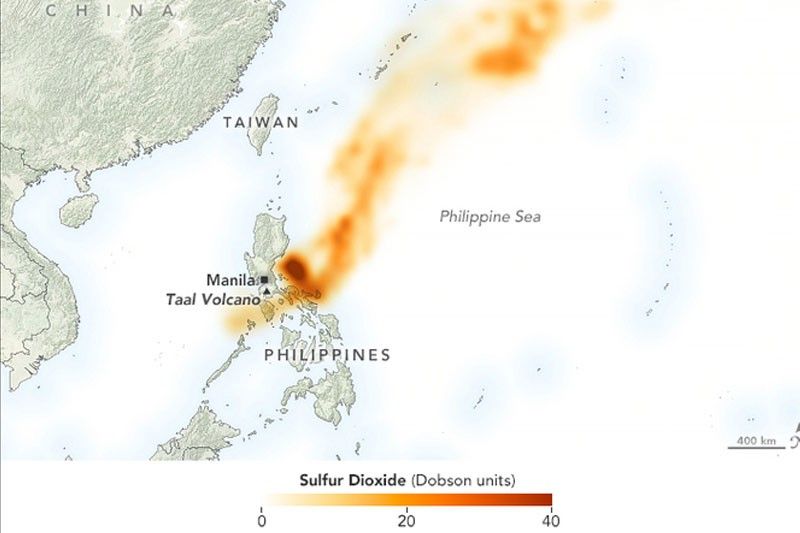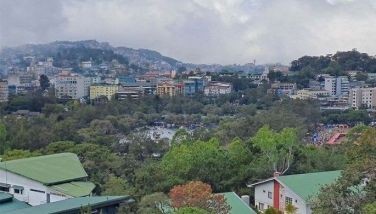Map shows Taal Volcano spewing sulfur into atmosphere

MANILA, Philippines — NASA Earth Observatory has observed the amount of sulfur dioxide that Taal Volcano has released into the air since its phreatic or steam-driven eruption last Sunday.
NASA has posted a map showing stratospheric dioxide concentrations on January 13,
While this amount has no measurable impacts on the climate yet, Michigan Technological University volcanologist
“However, it is possible that the Taal eruption could continue and produce more SO? in the coming days,” Carn told NASA Earth Observatory.
In January 2020, the #Taal Volcano awoke from 43 years of quiet and spewed lava and ash, filling streets and skies of the Philippine island of Luzon with fine ash and volcanic gases. https://t.co/LMGf7c37Wl #TaalEruption pic
— NASA Earth (@NASAEarth) January 14, 2020. twitter.com/EXOXjFwCvD
The Philippine Institute of Volcanology and Seismology said the volcano in Batangas province displayed "
However, Alert Level 4 remains under effect over Taal Volcano as hazardous explosive eruption is still possible within hours or days.
According to the US Geological Survey, SO? emissions can irritate the skin, eyes, nose and throat.
"SO2 emissions can cause acid rain and air pollution downwind of a volcano—at Kilauea volcano in Hawaii, high concentrations of sulfur dioxide produce volcanic smog causing persistent health problems for downwind populations," the USGS said on its website.
Get updates as Phivolcs issues warnings over activity in Taal Volcano. (Main photo by Philstar.com/Rosette Adel)
The Philippine Institute of Volcanology and Seismology issues a notice reporting an increased and continuous degassing activity from Taal Volcano.
In its 6 p.m. advisory, Phivolcs says the sulfur dioxide emission from the main crater reached 9762 tonnes per day. This was the higher recorded this year.
Phivolcs adds that there was no smog or vog observed. — Rosette Adel
The Philippine Institute of Volcanology and Seismology says Taal Volcano is still under Alert Level 1.
In an update on Wednesday, its says that the daily sulfur dioxide emissions (SO2) reached 2887 tonnes / day (06 October 2023).
Phivolcs also observes upwelling of hot volcanic fluids in the Main Crater Lake. — Rosette Adel
The Philippine Institute of Volcanology and Seismology reports that Taal Volcano's daily sulfur dioxide emissions (SO2) reached 2887 tonnes.
It observes upwelling of hot volcanic fluids in the Main Crater Lake as well as volcanic smog or vog.
The volcano's emissions are also 2400 meters tall. — Rosette Adel
The Philippine Institute of Volcanology and Seismology releases time-lapse snapshots of degassing activity from the Taal Main Crater and volcanic smog or vog formation on Sunday.
These were taken from 5:45 a.m. to 11:42 a.m. by the Mt. Macolot, Cuenca, Batangas station (VTCU) IP Camera.
LOOK: Time-lapse snapshots of degassing activity from the Taal Main Crater and volcanic smog or vog formation taken from 05:45 AM to 11:42 AM today, 8 October 2023 by the Mt. Macolot, Cuenca, Batangas station (VTCU) IP Camera. pic.twitter.com/jp48R1IZQy
— PHIVOLCS-DOST (@phivolcs_dost) October 8, 2023
— Rosette Adel
The Philippine Institute of Volcanology and Seismology records daily sulfur dioxide emissions that reached 2730 tonnes / day (22 September 2023).
It also observes upwelling of hot volcanic fluids in the Main Crater Lake and observed VOG.
Phivolcs adds that there is a ong-term deflation of the Taal Caldera; short-term inflation of the northern flanks of the Taal Volcano Island.
- Latest
- Trending


































